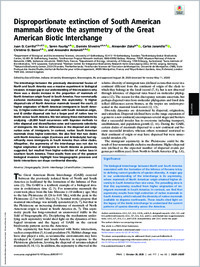Disproportionate extinction of South American mammals drove the asymmetry of the Great American Biotic Interchange
- Carrillo, Juan D. Department of Biological and Environmental Sciences, University of Gothenburg, SE-413 19 Gothenburg, Sweden - Gothenburg Global Biodiversity Centre, SE-405 30 Gothenburg, Sweden - Smithsonian Tropical Research Institute, 0843-03092 Balboa, Panama - CR2P, Muséum National d’Histoire Naturelle, CNRS, Sorbonne Université, 75005 Paris, France
- Faurby, Søren Department of Biological and Environmental Sciences, University of Gothenburg, SE-413 19 Gothenburg, Sweden - Gothenburg Global Biodiversity Centre, SE-405 30 Gothenburg, Sweden
- Silvestro, Daniele Department of Biological and Environmental Sciences, University of Gothenburg, SE-413 19 Gothenburg, Sweden - Gothenburg Global Biodiversity Centre, SE-405 30 Gothenburg, Sweden - Department of Biology, University of Fribourg, 1700 Fribourg, Switzerland - Swiss Institute of Bioinformatics, 1015 Lausanne, Switzerland
- Zizka, Alexander German Centre for Integrative Biodiversity Research Halle-Jena-Leipzig (iDiv), 04103, Leipzig, Germany - Naturalis Biodiversity Center, 2333 CR Leiden, The Netherlands
- Jaramillo, Carlos Smithsonian Tropical Research Institute, 0843-03092 Balboa, Panama - l’Institut des Sciences de l’Evolution de Montpellier, Université de Montpellier, CNRS, Ecole Pratique des Hautes Études, Institut de Recherche pour le Développement, 34095 Montpellier, France
- Bacon, Christine D. Department of Biological and Environmental Sciences, University of Gothenburg, SE-413 19 Gothenburg, Sweden - Gothenburg Global Biodiversity Centre, SE-405 30 Gothenburg, Sweden
- Antonelli, Alexandre Department of Biological and Environmental Sciences, University of Gothenburg, SE-413 19 Gothenburg, Sweden - Gothenburg Global Biodiversity Centre, SE-405 30 Gothenburg, Sweden
-
20.10.2020
Published in:
- Proceedings of the National Academy of Sciences. - 2020, vol. 117, no. 42, p. 26281–26287
English
The biological interchange between North and South America associated with the formation of the Isthmus of Panama is key to defining current gradients of species diversity. A major gap in our understanding of the interchange is its asymmetry, where mammals of North American origin attained higher diversity in South America than vice versa. The prevailing view is that this asymmetry resulted from higher origination of immigrant mammals in South America. In contrast, we find that asymmetry results from high extinction of native mammals in South America, which reduced the diversity of native mammals available to disperse northwards. These results shed light on the legacy of the biotic interchange to understand the current patterns of species diversity across the Americas.
- Faculty
- Faculté des sciences et de médecine
- Department
- Département de Biologie
- Language
-
- English
- Classification
- Biological sciences
- License
-
License undefined
- Identifiers
-
- RERO DOC 329730
- DOI 10.1073/pnas.2009397117
- Persistent URL
- https://folia.unifr.ch/unifr/documents/309099
Statistics
Document views: 165
File downloads:
- pdf: 245
